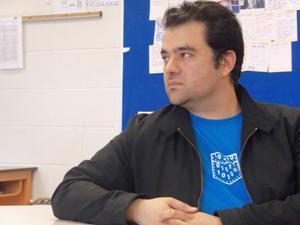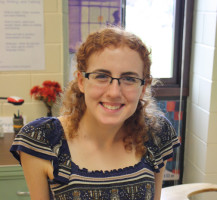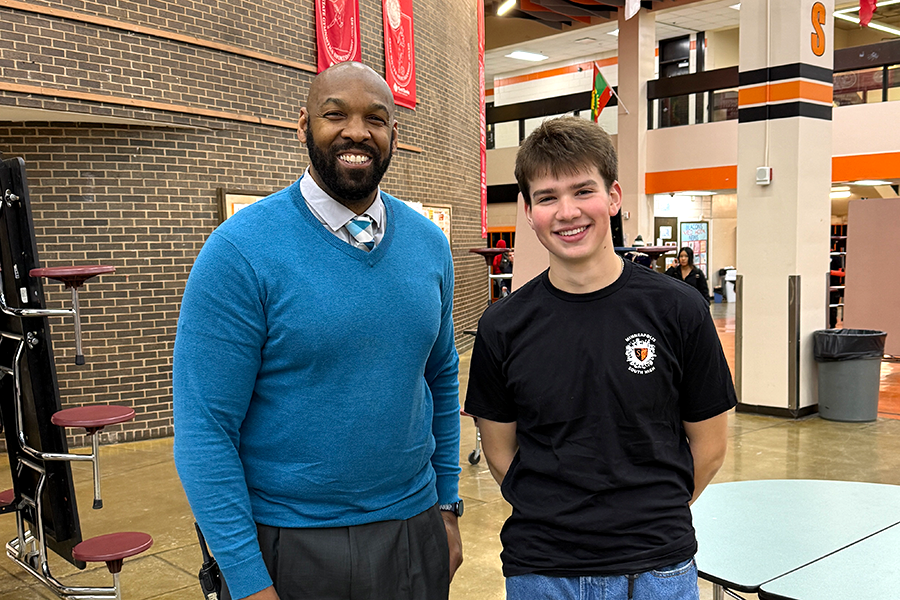University researcher studies cultural diversity in South’s classrooms

Roozbeh Shirazi, a researcher from the University of Minnesota, has been studying diversity at South. Most of his research has centered around classroom observation and conversations with teachers and students.
May 30, 2014
The first time Roozbeh Shirazi came to South, he stood in front of an Open classroom, and shared his story of being a first generation American with Iranian parents. That was 2012, and he’s still here.
Shirazi is a researcher from the University of Minnesota. This year he has been working in South on a research project that centers around racial and cultural diversity in the classroom. Because his work is not yet published, many of the specifics of his actual product had to be kept vague.
“I’m interested in finding ways to make schools responsive to all students and to be spaces that are welcoming and inclusive to all students,” Shirazi stated.
“I would say the broader goals of my research agenda are to help teachers identify existing practices that they have in the classroom, and to open up conversations around those. And then to collaboratively come up with ways to make the classrooms more open and responsive to the diversity of the student body.”
At South this translates into a lot of watching and notetaking. “Mostly I’m observing different classrooms and I’m speaking with different students and different teachers,” he said.
One teacher Shirazi has worked with is Lydia, not her real name, a teacher at South. “I really enjoy having Roozbeh here,” Lydia said. “He’s looking for how teachers and students interact throughout the day regarding diversity, cultural diversity.”
“I’ve been going back to high school again!” Shirazi laughed, reflecting on the experience. “Walking into the cafeteria and looking for a place to sit, that was a weird sense of deja vu.”
On top of observations in classes, Shirazi has been engaging in personal interviews with students from diverse cultural backgrounds.
Freshman Lucy, not her real name, has been in classes with Shirazi. “I see different races inside the classrooms, different people speaking, nobody really cares if you’re Black, White, Somali, Chinese, Asian,” Lucy reflected on her experiences with race in the classroom. “It doesn’t really matter.”
Through his research, Shirazi hopes to spread awareness “that the ways in which we recognize and talk about diversity in education is often times inadequate for engaging with the actual perspectives and lived experiences of students inside the classroom.”
Practically, this means finding a clearer translation for students’ cultures to enhance classroom experiences, rather than alienating students.
“We have a lot of students of color, we have a lot of students who are immigrants themselves or whose families have immigrated,” Shirazi added. “Their lives and their families and social practices are very rich and diverse and different. We need to be able to create schools that understand that and welcome that and in fact are built around that.”
Some classes at South have already begun developing curriculum around cultural sharing. In fact, it was this very value that brought Shirazi into South in the first place. During an Open English unit about the graphic novel Persepolis, which is set in the Iranian Revolution, Shirazi spoke on his history growing up Iranian in the US.
“I got some thoughtful questions from the students and the teachers,” Shirazi remembered. “I was really impressed by how intellectually curious people were.”
“We try to incorporate family stories into our learning, and family when they can come in,” described Lydia. During the same unit some parents of Iranian students shared with Shirazi. “We also . . . had a global sort of feast, and kids brought in foods from their cultures,” Lydia continued.
“You don’t walk in [to South] and feel like this is a school where students are primarily one group. And I think that’s really special, and I think that’s important,” reflected Shirazi.
“You don’t have too many spaces of encounter where people of different backgrounds are able to come together that I’ve observed in the Twin Cities, and so that’s something really important and unique about South.”
Despite the strides South has made for a more inclusive curriculum and welcoming school environment, work like Shirazi’s remains significant.
“There are a lot of things that need to change in how we approach education. I think some of it comes back to making sure teachers and schools have the support and resources they need to be more welcoming,” Shirazi stated. “A lot of it also entails a shift in perspective as there’s not one way to be or one right way to be . . . what is perceived to be “normal” is just as much social construct as anything else.”
“I think South is already doing wonderful things to help us and to help the Somali community,” said Lucy. She had just come from Friday prayer in the gym, a consideration made by the school for Muslim students. Lucy’s experience at South has been overall positive in her year here.
“We need to continue to have conversations about race and culture,” Lydia said, “we need to continue to work on having courageous conversations, real conversations about race and culture, we need to continue to include diverse authors and stories and writers, pieces of learning outside of that white cannon of men.”
Although much of the final product of Shirazi’s research remains unclear, he hopes that “some of the richness and life experiences of these students I’ve been talking to are heard and given greater weight and consideration.”
“I would like to be able to have it [the research] lead to more intentional conversations about what participation means, what it looks like, and how to make the classroom a welcoming space for all students,” Shirazi continued. “Beyond that I’m still figuring it out.”





